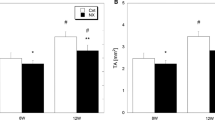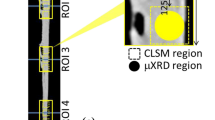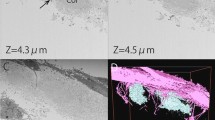Abstract
Little is known about hypoxia-induced modification of the canal network in the cortical bone despite its involvement in intracortical vascularity and bone blood supply. In this study, we examined the effect of chronic hypoxia on the canal network in postnatal bone. Tibiae were harvested from 4- and 8-week-old rats (hyp-4 and -8, n = 8 each), whose growth was retarded owing to postnatal exposure to hypoxia (12–14% O2), and from 3- and 4-week-old normoxic rats (cnt-4 and -5, n = 8 each), which were similar in tibial length and cortical cross-sectional area to hyp-4 and -8, respectively. The diaphyseal canals were detected by monochromatic synchrotron radiation CT with a 3.1-μm voxel resolution. The anatomical properties of the canal network were compared between age- or size-matched hypoxic and normoxic groups. The canals were larger in diameter, were more densely distributed and connected, and opened into the marrow cavity with a higher density in hyp-4 than in cnt-4. The canal density and connectivity were also higher in hyp-4 than in cnt-3. The canal diameter, density, and connectivity were smaller in hyp-8 than in cnt-4; however, the densities of endocortical and periosteal canal openings did not differ between hyp-8 and cnt-4. We concluded that chronic hypoxia enhanced the formation of cortical canal networks at the postnatal developmental stage, probably facilitating intra- and transcortical vascularization and bone perfusion accordingly.


Similar content being viewed by others
References
Morris MA, Kelly PJ (1980) Use of tracer microspheres to measure bone blood flow in conscious dogs. Calcif Tissue Int 32:69–76
Bloomfield SA, Hogan HA, Delp MD (2002) Decreases in bone blood flow and bone material properties in aging Fischer-344 rats. Clin Orthop 396:248–257
Vanderhoef PJ, Kelly PJ, Janes JM, Peterson LF (1963) Growth and structure of bone distal to an arteriovenous fistula: quantitative analysis of tetracycline-induced transverse growth patterns. J Bone Joint Surg Br 45:582–596
Griffith JF, Yeung DK, Antonio GE, Wong SY, Kwok TC, Woo J, Leung PC (2006) Vertebral marrow fat content and diffusion and perfusion indexes in women with varying bone density: MR evaluation. Radiology 241:831–838
Brookes M, Revell W (1998) Blood supply of bone: scientific aspects. Springer-Verlag, London
Brandi ML, Collin-Osdoby P (2006) Vascular biology and the skeleton. J Bone Miner Res 21:183–192
Gerber HP, Ferrara N (2000) Angiogenesis and bone growth. Trends Cardiovasc Med 10:223–228
Blumer MJ, Longato S, Fritsch H (2008) Structure, formation and role of cartilage canals in the developing bone. Ann Anat 190:305–315
Leterrier C, Constantin P (1999) Early bone growth in chickens genetically selected for a high and low growth rate. Growth Dev Aging 63:75–84
Williams B, Waddington D, Murray DH, Farquharson C (2004) Bone strength during growth: influence of growth rate on cortical porosity and mineralization. Calcif Tissue Int 74:236–245
Cooper DM, Thomas CD, Clement JG, Turinsky AL, Sensen CW, Hallgrímsson B (2007) Age-dependent change in the 3D structure of cortical porosity at the human femoral midshaft. Bone 40:957–965
Matsumoto T, Yoshino M, Uesugi K, Tanaka M (2007) Biphasic change and disuse-mediated regression of canal network structure in cortical bone of growing rats. Bone 41:239–246
Schnitzler CM, Mesquita JM, Pettifor JM (2009) Cortical bone development in black and white South African children: iliac crest histomorphometry. Bone 44:603–611
Hunter C, Clegg EJ (1973) Changes in skeletal proportions of the rat in response to hypoxic stress. J Anat 114:201–219
Nelson ML, Cons JM (1975) Pituitary hormones and growth retardation in rats raised at simulated high altitude (3800 m). Environ Physiol Biochem 5:273–282
Alippi RM, Barceló AC, Río ME, Bozzini CE (1983) Growth retardation in the early developing rat exposed to continuous hypobaric hypoxia. Acta Physiol Lat Am 33:1–5
Peterson RE, Wetzel GT (2004) Growth failure in congenital heart disease: where are we now? Curr Opin Cardiol 19:81–83
Witzel C, Sreeram N, Coburger S, Schickendantz S, Brockmeier K, Schoenau E (2006) Outcome of muscle and bone development in congenital heart disease. Eur J Pediatr 165:168–174
Vogt KN, Manlhiot C, Van Arsdell G, Russell JL, Mital S, McCrindle BW (2007) Somatic growth in children with single ventricle physiology impact of physiologic state. J Am Coll Cardiol 50:1876–1883
Weintraub RG, Menahem S (1993) Growth and congenital heart disease. J Paediatr Child Health 29:95–98
Semenza GL (2007) Regulation of tissue perfusion in mammals by hypoxia-inducible factor 1. Exp Physiol 92:988–991
Fong GH (2008) Mechanisms of adaptive angiogenesis to tissue hypoxia. Angiogenesis 11:121–140
Nakanishi K, Inoue M, Sugawara E, Sano S (1997) Ischemic and reperfusion injury of cyanotic myocardium in chronic hypoxic rat model: changes in cyanotic myocardial antioxidant system. J Thorac Cardiovasc Surg 114:1088–1096
Matsumoto T, Yoshino M, Asano T, Uesugi K, Todoh M, Tanaka M (2006) Monochromatic synchrotron radiation μCT reveals disuse-mediated canal network rarefaction in cortical bone of growing rat tibiae. J Appl Physiol 100:274–280
Maes F, Collignon A, Vandermeulen D, Marchal G, Suetens P (1997) Multimodality image registration by maximization of mutual information. IEEE Trans Med Imaging 16:187–198
Bonse U, Busch F (1996) X-ray computed microtomography (microCT) using synchrotron radiation (SR). Prog Biophys Mol Biol 65:133–169
Schneider P, Stauber M, Voide R, Stampanoni M, Donahue LR, Müller R (2007) Ultrastructural properties in cortical bone vary greatly in two inbred strains of mice as assessed by synchrotron light based micro- and nano-CT. J Bone Miner Res 22:1557–1570
Peyrin F (2009) Investigation of bone with synchrotron radiation imaging: from micro to nano. Osteoporos Int 20:1057–1063
Nuzzo S, Peyrin F, Cloetens P, Baruchel J, Boivin G (2002) Quantification of the degree of mineralization of bone in three dimensions using synchrotron radiation microtomography. Med Phys 29:2672–2681
Kazakia GJ, Burghardt AJ, Cheung S, Majumdar S (2008) Assessment of bone tissue mineralization by conventional X-ray microcomputed tomography: comparison with synchrotron radiation microcomputed tomography and ash measurements. Med Phys 35:3170–3179
Moromisato DY, Moromisato MY, Brasel JA, Cooper DM (1999) Effect of growth hormone therapy in mitigating hypoxia-induced and food restriction-induced growth retardation in the newborn rat. Crit Care Med 27:2234–2238
Tarasiuk A, Segev Y (2007) Chronic upper airway resistive loading induces growth retardation via the GH/IGF-I axis in prepubescent rats. J Appl Physiol 102:913–918
Utting JC, Robins SP, Brandao-Burch A, Orriss IR, Behar J, Arnett TR (2006) Hypoxia inhibits the growth, differentiation and bone-forming capacity of rat osteoblasts. Exp Cell Res 312:1693–1702
Bozec A, Bakiri L, Hoebertz A, Eferl R, Schilling AF, Komnenovic V, Scheuch H, Priemel M, Stewart CL, Amling M, Wagner EF (2008) Osteoclast size is controlled by Fra-2 through LIF/LIFreceptor signaling and hypoxia. Nature 454:221–225
Morris-Thurgood JA, Frenneaux MP (2000) Diastolic ventricular interaction and ventricular diastolic filling. Heart Fail Rev 5:307–323
Gurudevan SV, Malouf PJ, Auger WR, Waltman TJ, Madani M, Raisinghani AB, DeMaria AN, Blanchard DG (2007) Abnormal left ventricular diastolic filling in chronic thromboembolic pulmonary hypertension: true diastolic dysfunction or left ventricular underfilling? J Am Coll Cardiol 49:1334–1339
Bass DH, Adams LP, Tregidga A (1994) The effects of arterial interruption on bone growth in a rat model. S Afr J Surg 32:149–152
Chin AJ, Stephens P, Goldmuntz E, Leonard MB (2009) Serum alkaline phosphatase reflects post-Fontan hemodynamics in children. Pediatr Cardiol 30:138–145
Giuliani DC, Hall JC, Morse BS (1986) Strategies of hemopoietic stress adaptation within the medullary cavity. Anat Rec 216:528–533
Bozzini C, Olivera MI, Huygens P, Alippi RM, Bozzini CE (2009) Long-term exposure to hypobaric hypoxia in rat affects femur cross-sectional geometry and bone tissue material properties. Ann Anat 191:212–217
Parfitt AM (1983) The physiologic and clinical significance of bone histomorphometric data. In: Recker RR (ed) Bone histomorphometry: techniques and interpretation. CRC Press, Boca Raton, FL, pp 143–223
Boivin G, Meunier PJ (2002) The degree of mineralization of bone tissue measured by computerized quantitative contact microradiography. Calcif Tissue Int 70:503–511
Jowsey J (1964) Variations in bone mineralization with age and disease. In: Frost HM (ed) Bone biodynamics. Little Brown and Company, Boston, pp 461–479
Eriksen EF, Eghbali-Fatourechi GZ, Khosla S (2007) Remodeling and vascular spaces in bone. J Bone Miner Res 22:1–6
Wang Y, Wan C, Deng L, Liu X, Cao X, Gilbert SR, Bouxsein ML, Faugere MC, Guldberg RE, Gerstenfeld LC, Haase VH, Johnson RS, Schipani E, Clemens TL (2007) The hypoxia-inducible factor alpha pathway couples angiogenesis to osteogenesis during skeletal development. J Clin Invest 117:1616–1626
Schipani E, Maes C, Carmeliet G, Semenza GL (2009) Regulation of osteogenesis–angiogenesis coupling by HIFs and VEGF. J Bone Miner Res 24:1347–1353
Kiaer T (1994) Bone perfusion and oxygenation. Animal experiments and clinical observations. Acta Orthop Scand Suppl 257:1–41
Bridgeman G, Brookes M (1996) Blood supply to the human femoral diaphysis in youth and senescence. J Anat 188:611–621
McCarthy I (2006) The physiology of bone blood flow: a review. J Bone Joint Surg Am 88(Suppl 3):4–9
Jelkmann W (1992) Erythropoietin: structure, control of production, and function. Physiol Rev 72:449–489
Perloff JK (1993) Systemic complications of cyanosis in adults with congenital heart disease. Cardiol Clin 11:689–699
Tuttle JL, Nachreiner RD, Bhuller AS, Condict KW, Connors BA, Herring BP, Dalsing MC, Unthank JL (1997) Shear level influences resistance artery remodeling: wall dimensions, cell density, and eNOS expression. Am J Physiol Heart Circ Physiol 273:H628–H633
Koller A (2006) Flow-dependent remodeling of small arteries: the stimuli and the sensors are (still) in question. Circ Res 99:6–9
Humphrey JD (2008) Mechanisms of arterial remodeling in hypertension: coupled roles of wall shear and intramural stress. Hypertension 52:195–200
Skedros JG, Hunt KJ, Hughes PE, Winet H (2003) Ontogenetic and regional morphologic variations in the turkey ulna diaphysis: implications for functional adaptation of cortical bone. Anat Rec A Discov Mol Cell Evol Biol 273:609–629
Acknowledgments
The synchrotron radiation experiments were performed at SPring-8 with the approval of the Japan Synchrotron Radiation Research Institute. Part of this study was supported by Grants-in-Aid for Scientific Research (20300158) from the Ministry of Education, Culture, Sports, Science, and Technology.
Author information
Authors and Affiliations
Corresponding author
Additional information
The authors have stated that they have no conflict of interest.
Rights and permissions
About this article
Cite this article
Matsumoto, T., Ando, N., Tomii, T. et al. Three-Dimensional Cortical Bone Microstructure in a Rat Model of Hypoxia-Induced Growth Retardation. Calcif Tissue Int 88, 54–62 (2011). https://doi.org/10.1007/s00223-010-9415-7
Received:
Accepted:
Published:
Issue Date:
DOI: https://doi.org/10.1007/s00223-010-9415-7




